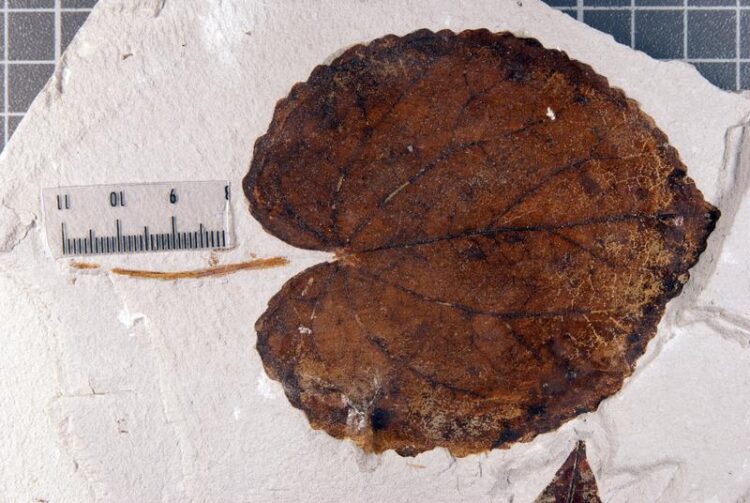When lush deciduous forests covered the Arctic

Leaf from a Pliocene tree of the genus Cercidiphyllum (C. crenatum) from the fossil site Willershausen (Germany’s Harz region)
(c) Stuttgart State Museum of Natural History
University of Tübingen team studies plant growth in the northern polar region some 50 million years ago – paleoclimate with parallels to current global warming.
Around 50 million years ago there were extensive, lush deciduous forests in the polar regions of the Arctic, where today there is sparse vegetation. The forests existed due to the conditions in the Eocene – a combination of a greenhouse climate and almost twice the level of carbon dioxide in the atmosphere as there is today. However, the same extreme light conditions prevailed in these regions of high latitude – permanent darkness for months on end in winter and a sun that never set in sum-mer, even if it was low in the sky.
There are no comparable environmental conditions on Earth today. In their new study, Dr. Dr. Wilfried Konrad and Dr. Christopher Traiser from the Department of Geosciences at the University of Tübingen, working with Dr. Anita Roth-Nebelsick from the State Museum of Natural History in Stuttgart, investigated the conditions under which the Eocene plants lived. The researchers wanted to know whether the plants were able to balance their light requirements, given the extremely differing hours of daylight and whether the large-leaved deciduous trees that were common at the time played a role in this. The researchers applied quantitative models of photosynthetic performance, which can replicate the specific light conditions, to fossil relatives of the Katsura tree (Cercidiphyllum japonicum). The study has been published in the journal Paleoceanography and Paleoclimatology.
Sophisticated models
Plants use sunlight to grow by converting water and carbon dioxide from the air into organic matter via photosynthesis, producing biomass such as branches and leaves. To learn more about the productivity of Arctic forests in the Eocene, the research team used data from two Arctic sites in the current study. The plant fossils came from Stenkul Fjord on Canada’s Ellesmere Island and from Spitsbergen in the Svalbard archipelago, which belongs to Norway. “For comparison, we used the northwestern Odenwald near Darmstadt in Germany. Although it is not located at a high latitude, but rather at mid-latitude, the climatic conditions in the deciduous forest there today are similar to those on Spitsbergen in the Eocene,” explains Konrad.
The Katsura or caramel tree (Cercidiphyllum japonicum) at Bebenhausen outside Tübingen. Foto: Anita Roth-Nebelsick and James Nebelsick
In their calculations on the productivity of the former Arctic forests, the researchers included numerous data to quantify evaporation and photosynthesis. They also examined how leaf size affected the exchange of gas and matter. “According to our results, whether the trees’ leaves were larger or smaller at that time did not play a decisive role,” says Konrad. Air temperature and light incidence, on the other hand, had an unexpectedly strong influence. Because Ellesmere Island was located a little further north than Spitsbergen, there were many more hours of sunshine during the annual vegetation period. Along with the slightly higher temperature on Ellesmere, this led to a much higher photosynthetic capacity than on Spitsbergen.
“Overall, we came up with surprisingly high forest productivity,” Konrad says. “We assume that climatic conditions in the Eocene enhanced the photosynthetic capacity of trees and thereby possibly also their biomass productivity. Based on current plant physiological data of the photosynthetic apparatus, photosynthetic output may have been at least 30 to 60 percent higher than at a temperate mid-latitude site today.” The main factor in the enhancement, he said, was the increased carbon dioxide content of the atmosphere. “An increase in the photosynthetic capacity of such forests could therefore also involve the currently rising carbon dioxide levels. However, since soil properties and light conditions have a major influence on plant productivity, the statements cannot be generalized,” says Konrad.
Future environmental scenarios
There are also no comparable habitats for global warming, Konrad says. “The environmental scenarios could change very quickly in some regions. Predicting future trends is a major challenge,” he says. “However, there were corresponding habitats in Earth’s past. Therefore, findings on paleoclimate can help improve models on future climate development and their predictions.”
Wissenschaftliche Ansprechpartner:
PD Dr. Dr. Wilfried Konrad
University of Tübingen
Faculty of Science
Department of Geoscience
Phone +49 7071 29-73073
wilfried.konrad[at]uni-tuebingen.de
Originalpublikation:
Wilfried Konrad, Anita Roth-Nebelsick, and Christopher Traiser: High productivity at high latitudes? Photosynthesis and leaf ecophysiology in Arctic forests of the Eocene. Paleoceanography and Paleoclimatology, https://doi.org/10.1029/2023PA004685
Media Contact
All latest news from the category: Earth Sciences
Earth Sciences (also referred to as Geosciences), which deals with basic issues surrounding our planet, plays a vital role in the area of energy and raw materials supply.
Earth Sciences comprises subjects such as geology, geography, geological informatics, paleontology, mineralogy, petrography, crystallography, geophysics, geodesy, glaciology, cartography, photogrammetry, meteorology and seismology, early-warning systems, earthquake research and polar research.
Newest articles
Faster, more energy-efficient way to manufacture an industrially important chemical
Zirconium combined with silicon nitride enhances the conversion of propane — present in natural gas — needed to create in-demand plastic, polypropylene. Polypropylene is a common type of plastic found…

Energy planning in Ghana as a role model for the world
Improving the resilience of energy systems in the Global South. What criteria should we use to better plan for resilient energy systems? How do socio-economic, technical and climate change related…

Artificial blood vessels could improve heart bypass outcomes
Artificial blood vessels could improve heart bypass outcomes. 3D-printed blood vessels, which closely mimic the properties of human veins, could transform the treatment of cardiovascular diseases. Strong, flexible, gel-like tubes…





















